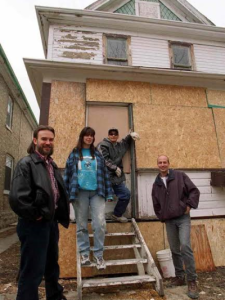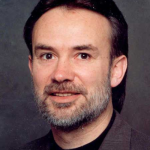
By Randy Tschetter
Director of the NAB Heritage Commission
 It was a cool October morning in 2005 in downtown Winnipeg, Manitoba. As my wife and I made our way toward the Ellice Avenue Café, we were approached by two homeless people, who apparently saw us as easy marks for something. We were greatly relieved when Harry Lehotsky appeared. He gently spoke to his friends, diverting their attentions away from us and rescuing us from the uncomfortable situation in which we found ourselves.
It was a cool October morning in 2005 in downtown Winnipeg, Manitoba. As my wife and I made our way toward the Ellice Avenue Café, we were approached by two homeless people, who apparently saw us as easy marks for something. We were greatly relieved when Harry Lehotsky appeared. He gently spoke to his friends, diverting their attentions away from us and rescuing us from the uncomfortable situation in which we found ourselves.
“Inner-City Angel” is how the Winnipeg Free Press described Harry Lehotsky following his death from pancreatic cancer in 2006.1 Lehotsky and his wife, Virginia, had moved to Winnipeg in 1983 at the request of several pastors, who encouraged him to start a church in their city’s West End.  Bible studies in an office building led to a decision to hold worship services there before New Life Ministries was established as an NAB church in 1986. Under Harry’s leadership, the church established Lazarus Housing, renovating former gang hangouts; Nehemiah Housing, providing affordable housing for the working poor; Connect 2, a voice mailbox service to help residents without phones get jobs; West End CIA, a community effort to shut down drug houses; and Ellice Café and Theater, providing volunteer and employment training.
Bible studies in an office building led to a decision to hold worship services there before New Life Ministries was established as an NAB church in 1986. Under Harry’s leadership, the church established Lazarus Housing, renovating former gang hangouts; Nehemiah Housing, providing affordable housing for the working poor; Connect 2, a voice mailbox service to help residents without phones get jobs; West End CIA, a community effort to shut down drug houses; and Ellice Café and Theater, providing volunteer and employment training.
 Lehotsky’s ministry was motivated by his love for God and a deep desire to inspire hope in the lives of people who had no reason to hope. It was the kind of ministry he had witnessed as a child attending the church once pastored by Walter Rauschenbusch in Hell’s Kitchen in New York City. It was the manifestation of the unconditional love he received from his family following a near-fatal drug overdose as a teen, as well as a radio challenge that asked, “What would it be like to help people in the inner city?”2
Lehotsky’s ministry was motivated by his love for God and a deep desire to inspire hope in the lives of people who had no reason to hope. It was the kind of ministry he had witnessed as a child attending the church once pastored by Walter Rauschenbusch in Hell’s Kitchen in New York City. It was the manifestation of the unconditional love he received from his family following a near-fatal drug overdose as a teen, as well as a radio challenge that asked, “What would it be like to help people in the inner city?”2
At the Niagara Falls Triennial in 1982, he asked those in attendance, “Whatever happened to the teaching that we’re commanded to fight for the rights of the poor? We need to care, absolutely, but the goal is to encourage someone out of a destructive life, not simply to feel sorry for them.”3
In describing Lehotsky’s life, Harold Jantz writes, “The key to calling these people to account [. . .] and still treating them with respect lay in his deep conviction that we are at one and the same time ‘sinners and people made in the image of God.’”4
 When confronted with the diagnosis of terminal cancer at age 49, he pointed out that soon he would meet the person he had been working for all these years. Some 3,000 people – from dignitaries to drug addicts – gathered to mourn the loss and celebrate the life and work of this Urban Saint.
When confronted with the diagnosis of terminal cancer at age 49, he pointed out that soon he would meet the person he had been working for all these years. Some 3,000 people – from dignitaries to drug addicts – gathered to mourn the loss and celebrate the life and work of this Urban Saint.
1. “Harry Lehotsky: Inner-City Angel,” Winnipeg Free Press, November 12, 2006.
2. Paul H. Boge, The Urban Saint: The Harry Lehotsky Story, (Winnipeg, MB: Horizon Press, 2010).
3. Boge, Urban Saint, p. 67.
4. Harold Jantz, Christian Week: Manitoba Edition, December 2006, p. 6.